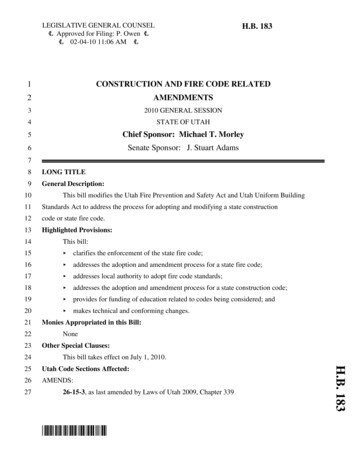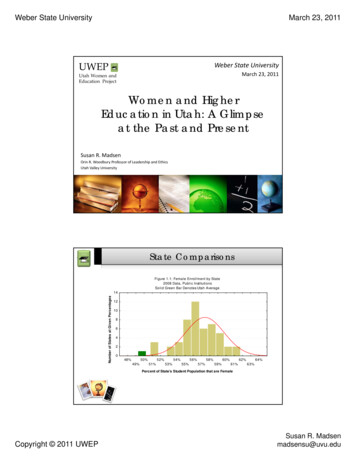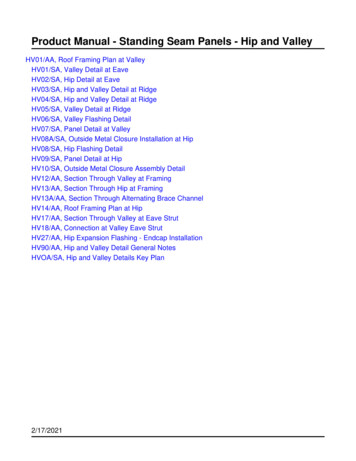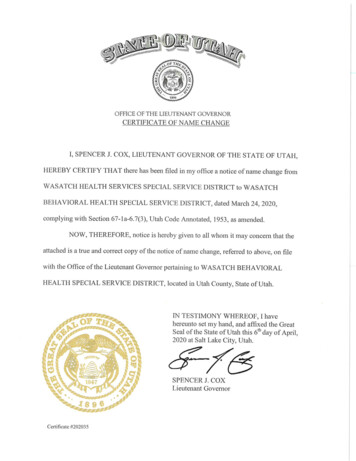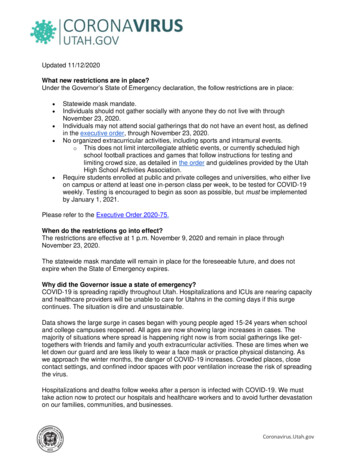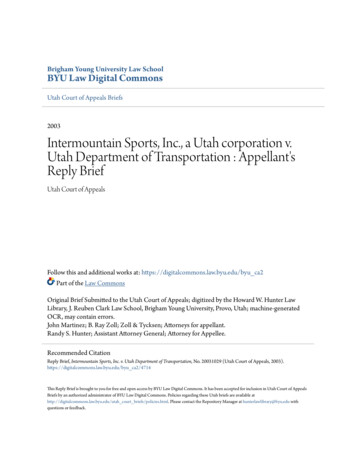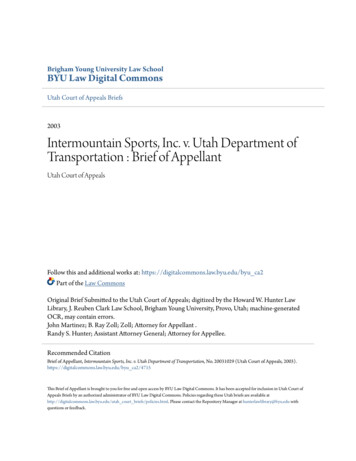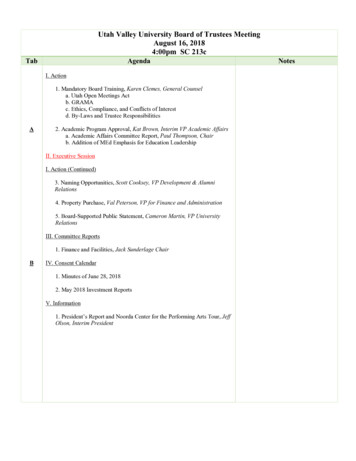
Transcription
Utah Valley University Board of Trustees MeetingAugust 16, 20184:00pm SC 213cTabAgendaI. Action1. Mandatory Board Training, Karen Clemes, General Counsela. Utah Open Meetings Actb. GRAMAc. Ethics, Compliance, and Conflicts of Interestd. By-Laws and Trustee ResponsibilitiesA2. Academic Program Approval, Kat Brown, Interim VP Academic Affairsa. Academic Affairs Committee Report, Paul Thompson, Chairb. Addition of MEd Emphasis for Education LeadershipII. Executive SessionI. Action (Continued)3. Naming Opportunities, Scott Cooksey, VP Development & AlumniRelations4. Property Purchase, Val Peterson, VP for Finance and Administration5. Board-Supported Public Statement, Cameron Martin, VP UniversityRelationsIII. Committee Reports1. Finance and Facilities, Jack Sunderlage ChairBIV. Consent Calendar1. Minutes of June 28, 20182. May 2018 Investment ReportsV. Information1. President’s Report and Noorda Center for the Performing Arts Tour, JeffOlson, Interim PresidentNotes
UVU BOARD OF TRUSTEESAgenda Item CoversheetDATE:August 16, 2018TITLE:Academic Program ApprovalEXECUTIVE/RESPONSIBLE Kat Brown, Interim VP for Academic AffairsSTAFF MEMBER:SUBJECT:Academic Program ApprovalBACKGROUND:At the recommendation of the Academic AffairsCommittee, the Board of Trustees is being asked toapprove the Academic Program addition:a. Master of Education (MEd) emphasis inEducational LeadershipALTERNATIVES: Approve as presented, “I move to approve thefollowing academic program changes ormodifications:a. Master of Education (MEd) emphasis inEducational Leadership.”FINANCIAL IMPACT:EXHIBITS: Amend and approve, “I move to approve, asamended ” No action, “I move that we go to the nextagenda item ”Available upon requesta. Master of Education (MEd) emphasis inEducational Leadership.”
Utah System of Higher EducationNew Academic Program ProposalCover/Signature Page—Abbreviated TemplateInstitution Submitting Request: Utah Valley UniversityProposed Program Title: The Master of Education (MEd) emphasis for Educational LeadershipSponsoring School, College, or Division: School of EducationSponsoring Academic Department(s) or Unit(s): School of Education Graduate StudiesClassification of Instructional Program Code: 13.0401Min/Max Credit Hours Required of Full Program: 36/36Proposed Beginning Term: Summer 2019Institutional Board of Trustees’ Approval Date: PendingProgram Type: X Certificate of ProficiencyCertificate of CompletionMinorGraduate CertificateK-12 Endorsement Entry-level CTE CP Mid-level CPNew Emphasis for Regent-Approved ProgramCredit Hours for NEW Emphasis Only: 36Current Major CIP: 13.301, 13.0401Current Program Title: Master of EducationCurrent Program BOR Approval Date:Out of Service Area Delivery ProgramChief Academic Officer (or Designee) Signature:I, the Chief Academic Officer or Designee, certify that all required institutional approvals have beenobtained prior to submitting this request to the Office of the Commissioner.Name:Date:1
Utah System of Higher EducationNew Academic Program ProposalSection I: The RequestThe Graduate Studies Program in the School of Education at Utah Valley University requestsapproval to offer the Master of Education (MEd) emphasis for Educational Leadership effectiveSummer 2019.Section II: Program Proposal/Needs AssessmentProgram Description/RationaleThe Educational Leadership emphasis in the Master of Education (MEd) is designed to buildindividual school leaders with competencies in five areas: Personal Leadership & OrganizationalDesign; Organizational Operations and Management; Leading Evidence-Based Curriculum,Instruction, & Assessment; Leading Professional Learning Communities; and Leading Change,Innovation, & Educational Entrepreneurship. The Educational Leadership emphasis will alloweducators with workplace experience and knowledge to pursue the coursework and practicumexperiences required to apply for a USBE Leadership Area of Concentration License. Candidatesare required to complete 400 hours of structured, supervised internship in addition to 50 hours ofclinical fieldwork embedded within coursework.The MEd emphasis in Educational Leadership is based on the proposed Utah EducationalLeadership Standard Revisions (October 2017) and the Professional Standards for EducationalLeaders (PSEL 2015). It prepares educational leaders for elementary and secondary schools, anddistrict offices. The leadership program is aligned with Utah Board of Education rules R277-505and meets requirements for the Educational Leadership License Area of Concentration.The Regents have designated UVU as a teaching institution that “provides opportunity, promotesstudent success, and meets regional educational needs” (USHE, R312). UVU’s role as a regionalstate university is to provide “quality academic learning opportunities for students throughprograms at the certificate, associate, baccalaureate, and graduate levels” (UVU MissionStatement). The program will fill an ongoing need for educational administrators in regional public,private, and charter schools. Program courses will originate at the Orem campus in a face-to-faceor hybrid format, but the program is expected to expand to UVU’s Thanksgiving Point campus.For the past two decades, the Utah Valley University School of Education has established a solidreputation for undergraduate teacher preparation with K-16 Alliance partnership districts. Duringthis time, the School of Education has developed the vision and capacity to offer a program to alsoprepare effective educational leaders for UVU’s service region. A UVU educational leadershipprogram will provide a more accessible and economical option to similar programs offered locally,and it will expand UVU’s influence in K-12 education as an advocate for effective professionalcompetencies for educational leadership in the K-16 Alliance.Both UVU and USHE will benefit by offering the proposed program. UVU will benefit from havingschool education leaders in the community who have been affiliated with the university. Graduates2
from the Educational Leadership emphasis will support the goals of public institutions asestablished by Utah Board of Education and USHE.Labor Market DemandLong-term Bureau of Labor Statistics (BLS) estimates the 2014-2024 growth rate for educational administrators(CIP 13.0401) within Utah to be about as fast as average with projected increases between 12-38.5%. Theseoccupations are projected to have a combined growth of about 190 new job openings in Utah annually. Accordingto the BLS, the median annual wage for these occupations is estimated to be 34,660 for preschool and childcareadministrators to 78,890-88,920 for secondary and postsecondary administrators. These wages are higher thanthe 2016 Utah median wage ( 35,010).Data for occupational supply and demand are drawn from the Bureau of Labor Statistics (BLS) forthese occupations within the state of Utah. They show that the annual median wage for educationadministrators in elementary and secondary schools was 88,920. The growth trend for 2014-2024shows the rate to be about as fast as average with increases between 20%, with about 90 new jobopenings in Utah annually. Typical education for these kinds of positions is a master’s degree, andjobholders in this area have five years or more work experience.The following information contains detailed, recent labor market data specifically for Utah duringthe past year (from March 2017-Feb 2018) for the SOC occupations that crosswalk to the 13.0401CIP program drawn from the Burning Glass Market Report1. There were 1,607 job postings in Utahfor all educational leadership positions in the last 12 months. Note that these job postings includeboth new and existing job positions and the volume of job postings may exceed the BLS estimates.Of the 1,607 postings, only 654 or 41% specify educational requirements. Of these positions 225,or 34%, require a graduate/ professional degree, although virtually all educational leadershippositions in traditional public education institutions require a master’s degree.The frequencies of these positions by Metropolitan Statistical Area (MSAs) show thegreatest number of positions in Salt Lake and Utah counties. Labor Insight/BurningGlass data indicates 1,607 job postings for education administrators in Utah duringthe past 12 months, much larger than the BLS estimate. The mean salary for theBurning Glass data (N 361) is 36k, which is much lower than the BLS estimatedmedian occupation wage.1Data SourcesUVU IRI relies heavily on 3 online resources for labor market data and analysis: Economic Development and Employer Planning System which articulates higher education program data with Bureau of LaborStatistics metrics for occupations at the national, state, and regional levels. The EDEPS is a dynamic analytical tool that accessesIPEDS and BLS data to quickly analyze higher education supply and labor market demands. This tool is free and includes additionalfeatures such as market area industry trends, higher education demographics, and labor market patterns. Burning Glass LaborInsight. This is also a web-based portal that aggregates nearly 200 million job postings collected every day from closeto 40,000 websites and other online sources. Since this data is updated daily, it is more sensitive to immediate labor market trends andallows for queries of the local labor job market in real-time. This resource compliments the broader longitudinal data analysis provided byEDEPS and together provide both an immediate, highly detailed current snapshot of the labor market as well as long-term trends andprojections for occupational supply and demand. UVU Institutional Research and Information data dashboards. The CTE enrollments dashboard and the UVU statistics dashboard aredynamic Tableau Dashboards that allow users to examine UVU enrollment data by college, department and major over several years. Thisdata provides visual enrollment trends for assessing student demand for programs and majors by degree level over time.3
The greatest frequency for these positions in the last 12 months occur in Salt LakeCity metropolitan area (544), with the Provo-Orem area having the second highestfrequency rate (393). The top Utah employers for secondary and elementaryinstitutions were listed (in order of the number of positions) as Granite School District,Nebo School District, Provo City School District, Alpine School District, Davis SchoolDistrict, Tooele County School District, Cache County School District, and CanyonsSchool District.Education administration occupations have had big year-over-year increases inopenings over the past 5 years. This field has experienced over 82% increase ingrowth since 2014.Student DemandThis proposed graduate program falls within UVU’s School of Education. An assessment of studentdemand is best drawn from enrollments for other existing departmental programs. Enrolled Fallheadcounts have been stable: 45 in 2012; 36 in 2013; 43 in 2014, 43 in 2015, and 44 in 2016.Overall, the program has experienced stable headcount, suggesting a strong demand by studentsfor an additional area of specialty in this department.In determining interest in an Educational Leadership emphasis, an online survey of current schooladministrators (N 52) in surrounding school districts was conducted by the UVU School ofEducation. It found that if a master’s level degree in educational administration had been availableat the time they began their degree program, more than 2/3 of the respondents indicated that theywould have seriously, or very seriously considered pursuing their degree at UVU.Three Year Projection: Program Participation and Department BudgetYear PrecedingImplementation Year 1Student Data# of Majors in Department# of Majors in Proposed Program(s)# of Graduates from Department# of Graduates in New Program(s)20New ProgramYearYear2Year 34Year 540402020Labor Market SupplyCurrently there are five programs in UVU’s service area offering a master’s program inEducational Leadership and Administration or higher – BYU, Argosy University, Universityof Phoenix-Utah, University of Utah, and Western Governor’s University. Of these, onlyUniversity of Utah is within the USHE system. Combined, 264 students graduated with a4
master’s in the area during 2015-16, which is an undersupply for demand as indicated bythe BLS and Burning Glass data.Similar ProgramsCurrently there are five programs in Utah offering a master’s program in Educational Leadershipand Administration or higher – BYU, Argosy University, University of Phoenix-Utah, University ofUtah, and Western Governor’s University. Of these, only University of Utah is within the USHEsystem. Combined, 264 students graduated with a Master’s in the area during 2015-16, which is anundersupply for demand as indicated by the BLS and Burning Glass data.Consistency with Institutional Mission/Impact on Other USHEInstitutionsThe Regents have recognized the distinct mission of UVU as a teaching institution that “providesopportunity, promotes student success, and meets regional educational needs” (USHE, R312).This mission is addressed in this proposal for a program designed to meet regional needs foradministrators in K-16 public, private, and charter schools. The leadership program will permitindividuals with workplace experience and meet admission requirements to pursue coursework andpracticum experiences required to apply for a USBE Educational Leadership License Area ofConcentration. This proposal also directly reflects UVU’s role as a regional state university, as itwill provide “quality academic learning opportunities for students through programs at thecertificate, associate, baccalaureate, and graduate levels” (UVU on.html ).FinancesThe first cohort (15 – 20 students) will begin in Summer 2019. One tenure-track position will beneeded to begin the program. Program completion requires a summer, fall, spring, summer, fall,spring. One cohort of students will be added each year, so beginning Summer 2020, two cohortswill run simultaneously. Additionally, because several courses are held in summer, ICHE hours willneed to be designated to cover summer courses. Additional staff and adjunct professor hours willbe required for advisement and for supervision and placement services for practicum experiencesin the schools. additional cost for these faculty/staff members in Financial Table below.5
# Non # Tenured # Tenure TenureTrackTrackFaculty: Full Time withDoctorateFaculty: Part Time withDoctorateFaculty: Full Time withMastersFaculty: Part Time withMastersFaculty: Full Time withBaccalaureateFaculty: Part Time withBaccalaureateTeaching / GraduateAssistantsStaff: Full Time1Academic orIndustryCredentialsNeededMaster’s degree andUtah EducationalLeadership licenseEst. % oftime to bededicated toproposedprogram.502Staff: Part TimeBecause the Master of Education program is designed for practicing educators, an additionalallotment of workload hours for the Summer term will be needed: nine credits for year one and 18credits for year two.6
Departmental Financial DataDepartment BudgetYear PrecedingProject additional expenses associated withImplementationoffering new program(s). Account for New(Base Budget)Faculty as stated in "Faculty Projections"Expenses- bature of additional costs requiredfor proposed program(s)Year 1Year 2Year 3Addition toBase Budgetfor NewProgram(s)Additionto BaseBudget forNewProgram(s)Additionto BaseBudget forNewProgram(s)List salary benefits for additional faculty/staff each year the positions will be filled. For example, if hiring faculty in year 2, includeexpense in years 2 and 3. List one-time operating expenses only in the year expended.Personnel (Faculty & Staff Salaryand Benefits)Operating Expenses (equipment,travel, resources)Other:Total Program Expenses 99,749 131,602 131,602 3,500 7,000 7,000 103,249 138,602 138,602 118,860 203,760 203,760 0 118,860 203,760 203,760 0 103,249 138,602 138,602 0Funding- Source of funding tocover additional costs generatedby proposed program(s)Describe internal reallocation using Narrative 1on the following page. Describe new sources offunding using Narrative 2.Internal ReallocationAppropriationSpecial Legislative appropriationGrants and ContractsSpecial FeesTuitionDifferential Tuition (requiresRegents approval)Total RevenuePROPOSED PROGRAM FUNDINGTOTAL DEPARTMENT FUNDINGDifference7
Section III: CurriculumProgram Curriculum:New Emphasis to an existing Regent approved programRequired EmphasisNewCoursesCoursesCourse TitleCreditHoursEDUC 6100Research Methodology3EDUC 6110Applied Statistics for Education3EDUC 6200Master’s Project3EDUC 6910Project 11EDUC 6920Project 21EDUC 693RProject 31Emphasis Core Credit Hour Subtotal:Elective EmphasisNewCoursesCoursesCourse Title12CreditHoursEDUC 632021st Century Teaching and Learning3EDUC 6330Diversity and Differentiation3Personal Leadership and OrganizationalDesignSchool Operations and Management Pt. 133EDUC 6120XEDUC 6130XEDUC 6140XEDUC 6150XInstructional Leadership and Data-basedDecision MakingSchool Operations and Management Pt. 2EDUC 6160XLeading Professional Learning Communities3EDUC 6170XLeading Change, Innovation and EducationalEntrepreneurshipEmphasis Elective Credit Hour Subtotal:3Emphasis Total Credit Hours:332436Program Curriculum NarrativeUpon successful completion of this program, students should have mastered the followingcompetencies that are aligned with the USBE Educational Leadership Standards:1) Visionary Leadership: Students should be able to implement policies and practices8
2)3)4)5)6)7)consistent a shared vision among faculty, staff, and community stakeholders thatpromotes each learner’s academic success and well-being.Teaching and Learning: Students should be able to establish collaborative and coherentsystems of curriculum, instruction, and assessment designed to promote each learner’sacademic success and well-being.Management for Learning: Students should be able to manage school operations andresources to promote the success and well-being of faculty, staff, and learners.Community Engagement: Students should be able to create an inclusive, caring, safe,and supportive school environment to promote each learner’s academic success andwell-being.Ethical Leadership: Students should be able to promote ethical and professionalbehavior among faculty, staff, and students to promote each learner’s success and wellbeing.School Improvement: Students should be able to act as agents of continuousimprovement and foster a professional community of teacher and staff to promote eachlearner’s academic success and well-being.Equity and Cultural Responsiveness: Students should be able to use culturallyresponsive practices that promote cultural competency and equity of educationopportunity in order to promote each learner’s academic success and well-being.In addition to program courses, these outcomes will be developed during field experiencesthroughout the program. During fall semester (1) and spring semester (2) students will complete50 hours of practicum in conjunction with their course work assignments/projects. During the firstsummer semester students will participate in a district instructional program, for example AlpineDistrict Summer Stars, or other specific district program involving instruction for 50 hours. Duringfall semester (3) students will complete eight hours per week for 19 weeks equaling 152 practicumhours in an elementary school. During spring semester (4) students will complete eight hours perweek for 19 weeks equaling 152 practicum hours in a secondary school. Nearing the end of thespring semester students will put in 32 hours in eight-hour blocks in a school, district office oranother district agency. During spring semester (4) students will complete 16 hours of practicumin a district office or another district agency. The total number of practicum hours will be 450.Clinical hours to be completed during the Educational Leadership program Practicum hours fulfilled within coursework assignment/projects, 50/first two semesters Field Practicum, 50 hours in Stars Program or other specific district program involvinginstruction Field Practicum, eight hours per week/19 weeks 152 days/semester (elementary school) Field Practicum, eight hours per week/19 weeks 152 days/semester (secondary school) Field Practicum, 32 hrs. in eight hr. blocks Field Practicum (during program), 16 hrs/semester work in district office or anotherdistrict agency, for two semestersTotal 450 (50 hours within coursework, 400 hours in practicum)9
The proposed Educational Leadership program is built around instructional modules based on aset of core competencies. These five modules, along with additional clinical experiences, aredesigned to produce highly effective educational leaders who can meet the needs of today'sdemanding and complex school environments. They are aligned with the Utah EducationalLeadership Standards (UELS) and the national Professional Standards for Educational Leaders(PSEL).Module 1: Personal Leadership & Organizational Design. Competency: This module is designedto produce school leaders who are knowledgeable about the functions of organizations asmechanism, systems, and complex adaptive systems; who understand the historical foundations ofleadership and current leadership theory; and who, as leaders, can act creatively, courageously,and ethically in an age of complexity and uncertainty. UELS 5; PSEL 2Module 2: School Operations and Management (in 2 parts). Competency: This module isdesigned to produce school leaders who are efficient/effective in scheduling, organizing, planning,strategizing, delegating, communicating, protecting, and budgeting for the success and well-beingof student, faculty, and staff. UELS 3; PSEL 9Module 3: Leading Evidence-Based Curriculum, Instruction, & Assessment (in 2 parts).Competency: This module is designed to produce school leaders who are skillful in facilitatingcoherent systems of curriculum development, impactful instruction, valid assessment, and datainterpretation/decision making for the success and well-begin of students and faculty. UELS 2;PSEL 4Module 4: Leading Professional Learning Communities (in 2 parts).Competency: This module isdesigned to produce school leaders with capacity to establish a school community that promotesprofessional progression and growth of faculty; inclusive, caring, and supportive environments forstudents; and connections to families and community for the success and well-being of studentsand faculty. UELS 4, 7; PSEL 3, 5, 6, 7, 8Module 5: Leading Change, Innovation & Educational Entrepreneurship. Competency: Thismodule is designed to produce school leaders with knowledge to build an organization withprinciple-centered core values and shared vision/mission and with effective theories and strategiesto advance positive innovation and educational change for the success and well-being of students,faculty, and staff. UELS 1, 6; PSEL 1, 10Degree Map:Summer of First Year(Course Prefix andNumber)EDUC 6120EDUC 6100EDUC 6110Fall of First Year(Course Prefix andNumber)Course TitlePersonal Leadership and Organizational DesignResearch MethodologyApplied Statistics for EducationCourse Title10CreditHours333CreditHours
EDUC 6130EDUC 6140Spring of First Year(Course Prefix andNumber)EDUC 6150EDUC 6160Summer of SecondYear(Course Prefix andNumber)EDUC 6320EDUC 6330EDUC 6170Fall of Second Year(Course Prefix andNumber)EDUC 6200Spring of SecondYear(Course Prefix andNumber)EDUC 6910EDUC 6920EDUC 693RSchool Operations & Management Part 1Instructional Leadership & Data-based Decision MakingCourse Title33CreditHoursOrganization Operations and Management Part 2Leading Professional Learning CommunitiesCourse Title33CreditHours21st Century Teaching and LearningDiversity and DifferentiationLeading Change, Innovation and EducationalEntrepreneurshipCourse Title333Master’s Project3CreditHoursCourse TitleProject 1Project 2Project 3CreditHours11111
UVU BOARD OF TRUSTEESAgenda Item CoversheetDATE:August 16, 2018TITLE:Consent CalendarEXECUTIVE/RESPONSIBLE Justin Jones, Chief of Staff & Secretary to theSTAFF MEMBER:BoardSUBJECT:Consent CalendarBACKGROUND:The Board of Trustees is being asked to approve theConsent Calendar which contains the followingitems:1. Minutes of June 28, 20182. May 2018 Investment ReportALTERNATIVES: Approve as presented, “I move to approve theconsent calendar as presented.” Amend and approve, “I move to approve, asamended ” No action, “I move that we go to the nextagenda item ”FINANCIAL IMPACT:Available upon requestEXHIBITS:a. Minutes of March 28, 2018b. June 2018 Investment Reports
UVU BOARD OF TRUSTEESJune 28, 20188 a.m. – SC 213c, Utah Valley UniversityBoard of Trustee Members PresentElaine Dalton, ChairJames ClarkeJohn GappmayerRick NielsenMarc ReynoldsJack Sunderlage, Second Vice ChairJill TaylorPaul ThompsonR. Duff Thompson, First Vice ChairGuestsSteve AndersonDavid ConnellyBraley DobsonBarbara SmithScott TrotterSummer ValenteJon WestoverUVU AttendeesKaren Clemes, General CounselScott Cooksey, Vice President Development and AlumniJustin Jones, Chief of Staff, Secretary to the BoardLinda Makin, Vice President Planning, Budgets, and HRShalece Nuttall, PACE PresidentJeff Olson, Interim President; Senior Vice President, Academic AffairsVal Peterson, Vice President Finance and AdministrationKyle Reyes, Vice President Student AffairsCraig Thulin, Faculty Senate PresidentKatie Zabriskie, Executive Communication OfficerI. ACTION1. Oath of OfficeTrustee Jack Sunderlage administered the Oath of Office to Marc Reynolds, the newly elected UVUSA StudentBody President. Trustee Reynolds was welcomed by the Board of Trustees.2. Executive Committee Vote RatificationTrustee Chair Elaine Dalton explained that on May 30, the Executive Committee was asked to vote on severalnaming opportunities that were time sensitive. One of those namings was to designate the Clarke BuildingAuditorium as “Holland Hall.” The other two namings were for the soccer fields in Vineyard and theEntrepreneurship Institute associated with the Woodbury School of Business. Both of these were contingent oncertain conditions being met within a specified timeframe. These contingencies have not yet been met and thosenaming approvals are no longer applicable as decided. Trustee Jill Taylor motioned to ratify the ExecutiveCommittee vote of May 30, 2018. Trustee John Gappmayer seconded. The motion carried without opposition.3. RequisitionsThe Trustees were presented with a requisition in the amount of 600,000 for the annual payment of WorkersCompensation insurance for UVU employees. Trustee R. Duff Thompson motioned to approve the requisition in theamount of 600,000 for Workers Compensation insurance. Trustee Taylor seconded. The motion carried withoutopposition. The Trustees were then presented with a requisition in the amount of 1,000,000 for the paving of thegravel parking lot at West Campus that will become free parking for employees and students. The bid submitted thatday was for 610,000 but approval of the requested amount will allow for contingency. Trustee Jack Sunderlagemotioned to approve the requisition in the amount of 1,000,000 for the paving of the West Campus parking lot.Trustee James Clarke seconded. The motion carried without opposition. Finally, the Trustees were presented with alist of annual requisitions in amounts near or above 500,000 These requests ensure that the university can buy foodand books for resale, pay IT vendors, utilities, and Orem City. The Trustees asked the President’s Council reconsiderthe thresholds of requisition approval and increase the amount for which Trustee vote is needed. Trustee D.Thompson motioned to approve the list of annual requisitions above 500,000 as presented. Trustee Gappmayerseconded. The motion carried without opposition.4. Center for Social Impact
The Trustees were presented with a proposal to change the name of the Volunteer and Service Learning Center toreflect a shift towards a more comprehensive scope in the purpose and offerings of the Center. The proposed newname is the Center for Social Impact. The Center for Social Impact will align itself more closely with programmodels that drive students into the community and expand beyond emphasis on service learning to includecommunity engagement, social entrepreneurship, philanthropy, and civic engagement. The Trustees engaged inactive discussion about the comprehensive model, the word “social” and alternative terms, and the need for aneducation and communication campaign around the Center for Social Impact. Trustee Reynolds motioned toapprove the change in name of the Volunteer and Service Learning Center to the Center for Social Impact. TrusteePaul Thompson seconded. The motion carried without opposition.5. PoliciesThe Trustees were presented with two policies to review. Policy 655 Graduate Studies was revised under a limitedscope to add clarification around graduate faculty clinical members and graduate director roles and responsibilities.The support of Faculty Senate was noted. Trustee P. Thompson motioned to approve the adoption of Policy 655Graduate Studies. Trustee Sunderlage seconded. The motion carried without opposition. Policy 204 Appropriatenessof Expenditures was being presented as temporary emergency revision. The existing policy was changed to removeprocedures for expenditures and to give greater emphasis to legal compliance and ethical stewardship of funds. Anew guideline for operations was created that reflects new systems, processes, and responsibilities. Trustee D.Thompson motioned to approve the adoption of Policy 204 Appropriateness of Expenditures. Trustee Taylorseconded. The motion carried without opposition.6. FacilitiesTrustee Sunderlage explained that the Finance and Facilities Committee met in May to discuss the items
Currently there are five programs in Utah offering a master's program in Educational Leadership and Administration or higher - BYU, Argosy University, University of Phoenix-Utah, University of Utah, and Western Governor's University. Of these, only University of Utah is within the USHE system. Combined, 264 students graduated with a .
